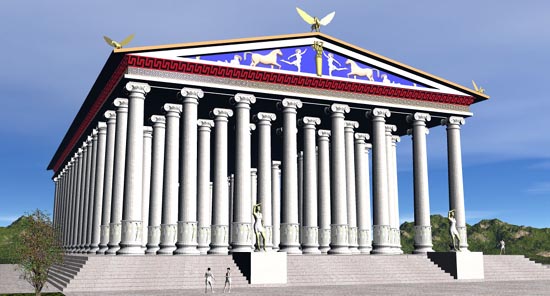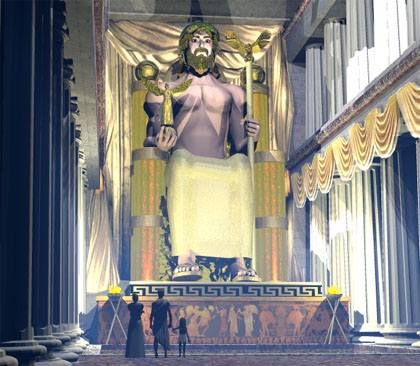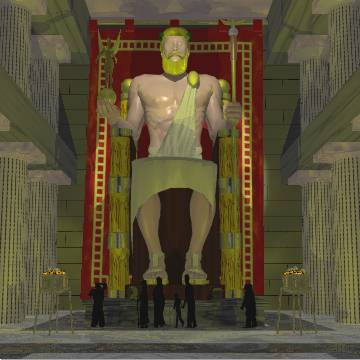Saturday, June 16, 2012
Thursday, June 14, 2012
Ancient World 7 Wonders - The Great Lighthouse at Alexandria
In the fall of 1994 a team of archaeological divers donned scuba equipment and entered the waters off of Alexandria, Egypt. Working beneath the surface, they searched the bottom of the sea for artifacts. Large underwater blocks of stone and remnants of sculpture were marked with floating masts so that an electronic distance measurement station on shore could obtain their exact positions. Global positioning satellites were then used to further fix the locations. The information was then fed into computers to create a detailed database of the sea floor.
Ironically, these scientists were using some of the most high-tech devices available at the end of the 20th century to try and sort out the ruins of one of the most advanced technological achievements of the 3rd century, B.C.. It was the Pharos, the great lighthouse of Alexandria, one of the Seven Wonders of the Ancient World.
Seven Quick Facts
|
| Location: Alexandria, Egypt. |
| Built: Around 290 - 270 BC |
| Function: Guide Ships to Alexandria's Harbor. |
| Destroyed: 1303 AD by earthquake. |
| Size: Height 450 ft. (140m) |
| Made of: Stone faced with white marble blocks with lead mortar. |
| Other: Said to be the only ancient wonder with a practical application. |
Alexander the Great
The story of the Pharos starts with the founding of the city of Alexandria by the Macedonian conqueror Alexander the Great in 332 B.C.. Alexander started at least 17 cities named Alexandria at different locations in his vast domain. Most of them disappeared, but Alexandria in Egypt thrived for many centuries and is prosperous even today.
Alexander the Great chose the location of his new city carefully. Instead of building it on the Nile delta, he selected a site some twenty miles to the west, so that the silt and mud carried by the river would not block the city harbor. South of the city was the marshy Lake Mareotis. After a canal was constructed between the lake and the Nile, the city had two harbors: one for Nile River traffic, and the other for Mediterranean Sea trade. Both harbors would remain deep and clear and the activity they allowed made the city very wealthy.
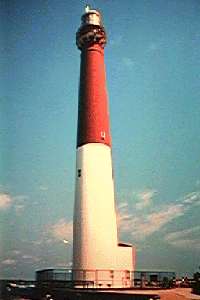
A modern lighthouse often is designed as just a single, slim column, unlike the Pharos.
|
Alexander died in 323 B.C. and the city was completed by Ptolemy Soter, the new ruler of Egypt. Under Ptolemy the city became rich and prosperous. However, it needed both a symbol and a mechanism to guide the many trade ships into its busy harbor. Ptolemy authorized the building of the Pharos in 290 B.C., and when it was completed some twenty years later, it was the first lighthouse in the world and the tallest building in existence, with the exception of the Great Pyramid. The construction cost was said to have been 800 talents, an amount equal today to about three million dollars.
Construction of the Lighthouse
The lighthouse's designer is believed to be Sostratus of Knidos (or Cnidus), though some sources argue he only provided the financing for the project. Proud of his work, Sostratus desired to have his name carved into the foundation. Ptolemy II, the son who ruled Egypt after his father, refused this request, wanting only his own name to be on the building. A clever man, Sostratus supposedly had the inscription:
SOSTRATUS SON OF DEXIPHANES OF KNIDOS ON BEHALF OF ALL MARINERS TO THE SAVIOR GODS
chiseled into the foundation, then covered it with plaster. Into the plaster was carved Ptolemy's name. As the years went by (and after both the death of Sostratus and Ptolemy) the plaster aged and chipped away, revealing Sostratus' dedication.
Ancient World 7 Wonders - The Colossus of Rhodes
New York City harbor see a marvelous sight. Standing on a small island in the harbor is an immense statue of a robed woman, holding a book and lifting a torch to the sky. The statue measures almost one-hundred and twenty feet from foot to crown. It is sometimes referred to as the "Modern Colossus," but more often called the Statue of Liberty.
This awe-inspiring statue was a gift from France to America and is easily recognized by people around the world. What many visitors to this shrine to freedom don't know is that the statue, the "Modern Colossus," is the echo of another statue, the original colossus, that stood over two thousand years ago at the entrance to another busy harbor on the Island of Rhodes. Like the Statue of Liberty, this colossus was also built as a celebration of freedom. This amazing statue, standing the same height from toe to head as the modern colossus, was one of the Seven Wonders of the Ancient World.
The Island of Rhodes
The island of Rhodes was an important economic center in the ancient world. It is located off the southwestern tip of Asia Minor where the Aegean Sea meets the Mediterranean. The capitol city, also named Rhodes, was built in 408 B.C. and was designed to take advantage of the island's best natural harbor on the northern coast.
Seven Quick Facts
|
| Location: Island of Rhodes (Modern Greece) |
| Built: Between 292 - 280 BC |
| Function: Commemorate War Victory |
| Destroyed: 226 BC by an earthquake |
| Size: Height without 50 foot pedestal was 110 ft. (30m) |
| Made of: Bronze plates attached to iron framework |
| Other: Made in the shape of the island's patron god Helios |
In 357 B.C. the island was conquered by Mausolus of Halicarnassus (whose tomb is one of the other Seven Wonders of the Ancient World) but fell into Persian hands in 340 BC and was finally captured by Alexander the Great in 332 BC. When Alexander died of a fever at an early age, his generals fought bitterly among themselves for control of Alexander's vast kingdom. Three of them, Ptolemy, Seleucus, and Antigous, succeeded in dividing the kingdom among themselves. The Rhodians supported Ptolemy (who wound up ruling Egypt) in this struggle. This angered Antigous who in 305 BC sent his son Demetrius to capture and punish the city of Rhodes.
The War with Demetrius
The war was long and painful. Demetrius brought an army of 40,000 men. This was more than the entire population of Rhodes. He also augmented his force by using Aegean pirates.
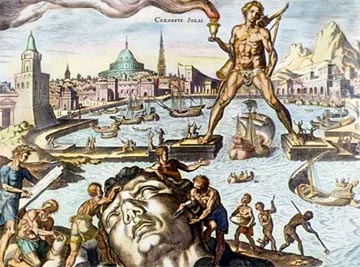
An engraving by Martin Heemskerck in 16th-century helped to establish the inaccurate harbor spanning pose in people's minds.
|
The city was protected by a strong, tall wall and the attackers were forced to use siege towers to try and climb over it. Siege towers were wooden structures that could be moved up to a defender's walls to allow the attackers to climb over them. While some were designed to be rolled up on land, Demetrius used a giant tower mounted on top of six ships lashed together to make his attack. This tower, though, was turned over and smashed when a storm suddenly approached, causing the battle to be won by the Rhodians.
Demetrius had a second super tower built and called it the Helepolis which translates to "Taker of Cities." This massive structure stood almost 150 feet high and some 75 feet square at the base and weight 160 tons. It was equipped with many catapults and skinned with wood and leather to protect the troops inside from archers. It even carried water tanks that could be used to fight fires started by flaming arrows. This tower was mounted on iron wheels and it could be rolled up to the walls under the power of 200 soldiers turning a large capstan.
When Demetrius attacked the city, the defenders stopped the war machine by flooding a ditch outside the walls and miring the heavy monster in the mud. By then almost a year had gone by and a fleet of ships from Egypt arrived to assist Rhodes. Demetrius withdrew quickly, leaving the great siege tower where it was. He signed a peace treaty and called his siege a victory as Rhodes agreed to remain neutral in his war against Ptolemy.
Ancient World 7 Wonders - The Mausoleum at Halicarnassus
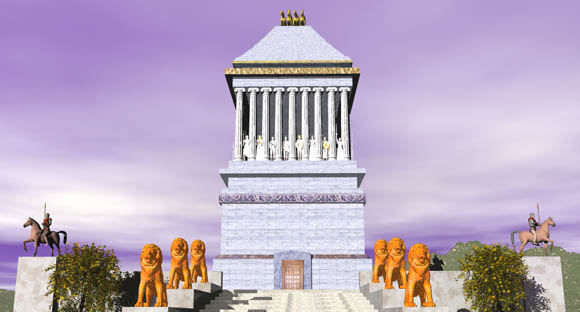 |
In 377 B.C., the city of Halicarnassus was the capitol of a small kingdom along the Mediterranean coast of Asia Minor. It was in that year the ruler of this land, Hecatomnus of Mylasa, died and left control of the kingdom to his son, Mausolus. Hecatomnus, a local satrap to the Persians, had been ambitious and had taken control of several of the neighboring cities and districts. Then Mausolus during his reign extended the territory even further so that it eventually included most of southwestern Asia Minor.
Mausolus, with his queen Artemisia, ruled over Halicarnassus and the surrounding territory for 24 years. Though he was descended from the local people, Mausolus spoke Greek and admired the Greek way of life and government. He founded many cities of Greek design along the coast and encouraged Greek democratic traditions.
Mausolus's Death
Seven Quick Facts
|
| Location: Halicarnassus (Modern Bodrum, Turkey) |
| Built: Around 350 B.C. |
| Function: Tomb for the City King, Mausolus |
| Destroyed: Damaged by earthquakes in 13th century A.D. . Final destruction by Crusaders in 1522 A.D. |
| Size: 140 feet (43m) high. |
| Made of: White Marble |
| Other: Built in a mixture of Egyptian, Greek and Lycian styles |
Then in 353 B.C. Mausolus died, leaving his queen Artemisia, who was also his sister, broken-hearted (It was the custom in Caria for rulers to marry their own sisters). As a tribute to him, she decided to build him the most splendid tomb in the known world. It became a structure so famous that Mausolus's name is now associated with all stately tombs throughout the world through the word mausoleum. The building, rich with statuary and carvings in relief, was so beautiful and unique it became one of the Seven Wonders of the Ancient World.
Artemisia decided that no expense was to be spared in the building of the tomb. She sent messengers to Greece to find the most talented artists of the time. These included architects Satyros and Pytheos who designed the overall shape of the tomb. Other famous sculptors invited to contribute to the project were Bryaxis, Leochares, Timotheus and Scopas of Paros (who was responsible for rebuilding the Temple of Artemis at Ephesus, another of the wonders). According to the historian Pliny Bryaxis, Leochares, Timotheus and Scopas each took one side of the tomb to decorate. Joining these sculptors were also hundreds of other workmen and craftsmen. Together they finished the building in the styles of three different cultures: Egyptian, Greek and Lycian.
The tomb was erected on a hill overlooking the city. The whole structure sat in the center of an enclosed courtyard on a stone platform. A staircase, flanked by stone lions, led to the top of this platform. Along the outer wall of the courtyard were many statues depicting gods and goddesses. At each corner stone warriors, mounted on horseback, guarded the tomb.

A map of the city of Halicarnassus drawn by the archeologist J D Barbié du Bocage in 1802 showing the tomb in the middle of the city.
|
At the center of the platform was the tomb itself. Made mostly of marble, the structure rose as a square, tapering block to about one-third of the Mausoleum's 140 foot height. This section was covered with relief sculpture showing action scenes from Greek myth/history. One part showed the battle of the Centaurs with the Lapiths. Another depicted Greeks in combat with the Amazons, a race of warrior women. On top of this section of the tomb thirty-six slim columns rose for another third of the height. Standing in between each column was another statue. Behind the columns was a solid block that carried the weight of the tomb's massive roof.
The roof, which comprised most of the final third of the height, was in the form of a stepped pyramid with 24 levels. Perched on top was the tomb's penultimate work of sculpture craved by Pytheos: Four massive horses pulling a chariot in which images of Mausolus and Artemisia rode.
Ancient World 7 Wonders - The Temple of Artemis at Ephesus
1100 A.D.: A troop of Crusaders stops at a muddy little village in Asia Minor. Their leader looks around. Confused he dismounts. This place is not what he expected. He read in the ancient texts that this was a large seaport with many ships docked in its bay. It isn't. The sea is almost three miles away. The village is located in a swamp. There are no ships to be seen. The leader accosts a nearby man.
Seven Quick Facts
|
| Location: Ephesus (Present day Turkey) |
| Built: Around 323 BC |
| Function: Temple to Goddess Artemis |
| Destroyed: 262 AD by Goths |
| Size: Length 425 ft. (129m) |
| Made of: Mostly marble |
| Other: Largest in a series of temples to Artemis on this site. |
"Sir, is this the city of Ephesus?"
"It was called that once. Now it is named Ayasalouk."
"Well, where is your bay? Where are the trading ships? And where is the magnificent Greek temple that we have heard about?"
Now it is the man's turn to be confused."Temple? What temple, Sir? We have no temple here..."
And so 800 years after its destruction, the magnificent Temple of Artemis at Ephesus, one of the Seven Wonders of the Ancient World, had been completely forgotten by the people of the town that had once held it in such pride.
And there is no doubt that the temple was indeed magnificent. "I have seen the walls and Hanging Gardens of ancient Babylon," wrote Philon of Byzantium, "the statue of Olympian Zeus, the Colossus of Rhodes, the mighty work of the high Pyramids and the tomb of Mausolus. But when I saw the temple at Ephesus rising to the clouds, all these other wonders were put in the shade."
Ancient World 7 Wonders - The Statue of Zeus at Olympia
In eancient times one of the Greeks most mportant festivals, the Olympic Games, was held every four years in honor of the King of their gods, Zeus. Like our modern Olympics, athletes traveled from distant lands, including Asia Minor, Syria, Egypt and Sicily, to compete. The Olympics were first started in 776 B.C. and held at a shrine to Zeus located on the western coast of Greece in a region called Peloponnesus. The games helped to unify the Greek city-states and a sacred truce was declared. Safe passage was given to all traveling to the site, called Olympia, for the season of the games.
The Temple at Olympia
The site consisted of a stadium - where the competitions were actually done - and a sacred grove, or Altis, where a number of temples were located. The shrine to Zeus here was simple in the early years, but as time went by and the games increased in importance, it became obvious that a new, larger temple, one worthy of the King of the gods, was needed. Between 470 and 460 B.C., construction on a new temple was started. The designer was Libon of Elis and his masterpiece, The Temple of Zeus, was completed in 456 B.C..
Seven Quick Facts
|
| Location: Peloponnesus (Modern Greece) |
| Built: Around 432 BC |
| Function: Shine to Greek God Zeus |
| Destroyed: Fire 5th Century A.D. |
| Size: Height around 40 ft. (12m) |
| Made of: Ivory and gold-plated plates on wooden frame. |
| Other: Remains of the workshop where it was built was found during an excavation in the 1950's |
This temple followed a design used on many large Grecian temples. It was similar to the Parthenon in Athens and the Temple of Artemis in Ephesus. The temple was built on a raised, rectangular platform. Thirteen large columns supported the roof along the sides and six supported it on each end. A gently-peaked roof topped the building. The triangles, or "pediments," created by the sloped roof at the ends of the building were filled with sculpture. Under the pediments, just above the columns, was more sculpture depicting the twelve labors of Heracles, six on each end of the temple.
Though the temple was considered one of the best examples of the Doric design because of its style and the quality of the workmanship, it was decided the temple alone was too simple to be worthy of the King of the gods. To remedy this, a statue was commissioned for the interior. It would be a magnificent statue of Zeus that would become one of the Seven Wonders of the Ancient World.
A Statue Worthy of the King of the Gods
The sculptor chosen for this great task was a man named Phidias. He had already rendered a forty-foot high statue of the goddess Athena for the Parthenon in Athens and had also done much of the sculpture on the exterior of that temple. After his work in Athens was done, Phidias traveled to Olympia around 432 B.C. to start on what was to be considered his best work, the statue of Zeus. On arriving he set up a workshop to the west of the temple. He would take the next 12 years to complete the project.
According to accounts, the statue when finished was located at the western end of the temple. It was 22 feet wide and more than 40 feet tall. The figure of Zeus was seated on an elaborate throne. His head nearly grazed the roof. The historian Strabo wrote, "...although the temple itself is very large, the sculptor is criticized for not having appreciated the correct proportions. He has depicted Zeus seated, but with the head almost touching the ceiling, so that we have the impression that if Zeus moved to stand up he would unroof the temple..."

The Lincoln Memorial with its single large statue and columns probably is very much like the temple of Zeus except the statue of the King of the Gods was more than double the height of Lincoln.
|
Others who viewed that temple disagreed with Strabo and found the proportions very effective in conveying the god's size and power. By filling nearly all the available space, the statue was made to seem even larger than it really was.
Philo of Byzantium, who wrote about all of the wonders, was certainly impressed. "Whereas we just wonder at the other six wonders, we kneel in front of this one in reverence, because the execution of the skill is as incredible as the image of Zeus is holy…"
In 97 A.D. another visitor Dio Crysostomos declared the image was so powerful that, "If a man, with a heavy heart from grief and sorrow in life, will stand in front of the statue, he will forget all these."
In his right hand the statue held the figure of Nike (the goddess of victory) and in its left was a scepter "inlaid with every kind of metal..." which was topped with an eagle. Perhaps even more impressive than the statue itself was the throne made out of gold, ebony, ivory and inlaid with precious stones. Carved into the chair were figures of Greek gods and mystical animals, including the half man/half lion sphinx.
Ancient World 7 Wonders - The Hanging Gardens of Babylon
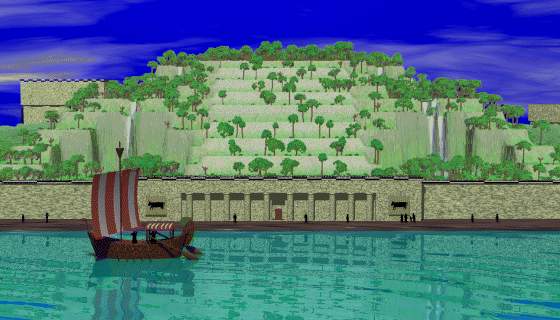
Some stories indicate the Hanging Gardens towered hundreds of feet into the air, but archaeological explorations indicate a more modest, but still impressive, height.(Copyright Lee Krystek, 1998)
The city of Babylon, under King Nebuchadnezzar II, must have been a wonder to the ancient traveler's eyes. "In addition to its size," wrote Herodotus, a Greek historian in 450 BC, "Babylon surpasses in splendor any city in the known world."
Herodotus claimed the outer walls were 56 miles in length, 80 feet thick and 320 feet high. Wide enough, he said, to allow two four-horse chariots to pass each other. The city also had inner walls which were "not so thick as the first, but hardly less strong." Inside these double walls were fortresses and temples containing immense statues of solid gold. Rising above the city was the famous Tower of Babel, a temple to the god Marduk, that seemed to reach to the heavens.
Seven Quick Facts
|
| Location: City State of Babylon (Modern Iraq) |
| Built: Around 600 BC |
| Function: Royal Gardens |
| Destroyed: Earthquake, 2nd Century BC |
| Size: Height probably 80 ft. (24m) |
| Made of: Mud brick waterproofed with lead. |
| Other: Only wonder whose archaeological remains cannot be verified. |
While archaeological excavations have disputed some of Herodotus's claims (the outer walls seem to be only 10 miles long and not nearly as high) his narrative does give us a sense of how awesome the features of the city appeared to those ancients that visited it. Strangely, however, one of the city's most spectacular sites is not even mentioned by Herodotus: The Hanging Gardens of Babylon, one of the Seven Wonders of the Ancient World.
Gift for A Homesick Wife
Accounts indicate that the garden was built by King Nebuchadnezzar, who ruled the city for 43 years starting in 605 BC (There is an alternative story that the gardens were built by the Assyrian Queen Semiramis during her five year reign starting in 810 BC). This was the height of the city's power and influence and King Nebuchadnezzar is known to have constructed an astonishing array of temples, streets, palaces and walls.
According to accounts, the gardens were built to cheer up Nebuchadnezzar's homesick wife, Amyitis. Amyitis, daughter of the king of the Medes, was married to Nebuchadnezzar to create an alliance between the two nations. The land she came from, though, was green, rugged and mountainous, and she found the flat, sun-baked terrain of Mesopotamia depressing. The king decided to relieve her depression by recreating her homeland through the building of an artificial mountain with rooftop gardens.
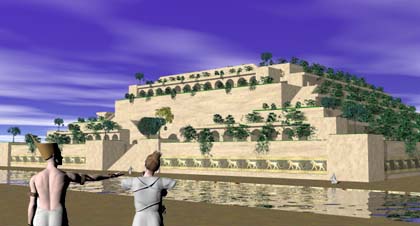
The Hanging Gardens were said to have been built to please King Nebuchadnezzar's wife, Amyitis. (Copyright Lee Krystek, 2010)
|
The Hanging Gardens probably did not really "hang" in the sense of being suspended from cables or ropes. The name comes from an inexact translation of the Greek word kremastos,or the Latin wordpensilis, which means not just "hanging", but "overhanging" as in the case of a terrace or balcony.
The Greek geographer Strabo, who described the gardens in first century BC, wrote, "It consists of vaulted terraces raised one above another, and resting upon cube-shaped pillars. These are hollow and filled with earth to allow trees of the largest size to be planted. The pillars, the vaults, and terraces are constructed of baked brick and asphalt."
"The ascent to the highest story is by stairs, and at their side are water engines, by means of which persons, appointed expressly for the purpose, are continually employed in raising water from the Euphrates into the garden."
Ancient World 7 Wonders - Khufu's Great Pyramid
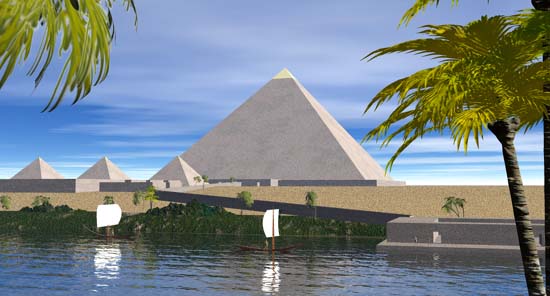 The Great Pyramid and its surrounding complex soon after its completion (Copyright Lee Krystek, 2010) |
It's 756 feet long on each side, 450 feet high and is composed of 2,300,000 blocks of stone, each averaging 2 1/2 tons in weight. Despite the makers' limited surveying tools, no side is more than 8 inches different in length than another, and the whole structure is perfectly oriented to the points of the compass. Even in the 19th century, it was the tallest building in the world and, at the age of 4,500 years, it is the only one of the famous "Seven Wonders of the Ancient World" that still stands. Even today it remains the most massive building on Earth. It is the Great Pyramid of Khufu, at Giza, Egypt.
Seven Quick Facts
|
| Location: Giza, Egypt |
| Built: Around 2560 BC |
| Function: Tomb of Pharoah Khufu |
| Destroyed: Still stands today. |
| Size: Height 480 ft. (146m) |
| Made of: Mostly limestone |
| Other: Tallest building in the world till 1311 AD and again from 1647 to 1874. |
Some of the earliest history of the Pyramid comes from a Greek the historian and traveler Herodotus of Halicanassus. He visited Egypt around 450 BC and included a description of the Great Pyramid in a history book he wrote. Herodotus was told by his Egyptian guides that it took twenty years for a force of 100,000 oppressed slaves to build the pyramid (with another 10 years to build a stone causeway that connected it to a temple in the valley below). Stones were lifted into position by the use of immense machines. The purpose of the structure, according to Herodotus's sources, was as a tomb for the Pharaoh Khufu (whom the Greeks referred to as Cheops).
Herodotus, a Greek from the democratic city of Athens, probably found the idea of a single man employing such staggering wealth and effort on his tomb an incredible act of egotism. He reported that even thousands of years later the Egyptians still hated Khufu for the burden he had placed on the people and could hardly bring themselves to speak his name.
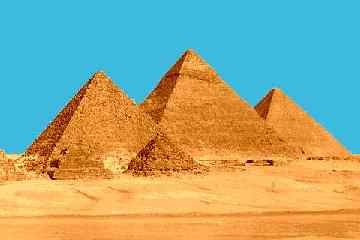
The three large pyramids at Giza: From left to right, Menkaure, Khafre, Khufu. The far pyramid is the "Great Pyramid" and the largest structure on the site. The middle one may look larger, but only because it is built on higher ground.
|
However, Khufu's contemporary Egyptian subjects may have seen the great pyramid in a different light. To them the pharaoh was not just a king, but a living god who linked their lives with those of the immortals. The pyramid, as an eternal tomb for the pharaoh's body, may have offered the people reassurance of his continuing influence with the gods. The pyramid wasn't just a symbol of regal power, but a visible link between earth and heaven.
Indeed, many of the stories Herodotus relates to us are probably false. Engineers calculate that fewer men and less years were needed than Herodotus suggests to build the structure. It also seems unlikely that slaves or complicated machines were needed for the pyramid's construction. It isn't surprising that the Greek historian got it wrong, however. By the time he visited the site, the structure was already 20 centuries old, and much of the truth about it was shrouded in the mists of history.
Certainly the idea that it was a tomb for a Pharaoh, though, seems in line with Egyptian practices. For many centuries before and after the construction of the Great Pyramid, the Egyptians had interned their dead Pharaoh-Kings, whom they believed to be living Gods, in intricate tombs. Some were above-ground structures, like the pyramid, others were cut in the rock underground. All the dead leaders were outfitted with the many things it was believed they would need in the afterlife to come. Many were buried with untold treasures.
Cape Sounio, Greece
Cape Sounio, a set on Flickr.
Tags
Travel
Subscribe to:
Comments (Atom)


